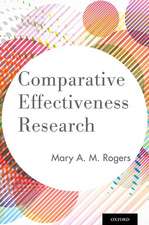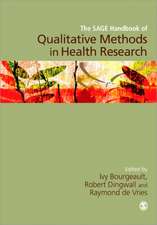Scorpion Venoms: Toxinology
Editat de P. Gopalakrishnakone, Lourival D. Possani, Elisabeth F. Schwartz, Ricardo C. Rodríguez de la Vegaen Limba Engleză Hardback – 21 ian 2015
This volume provides chapters that are accessible to a broad audience, yet also contains the depth of knowledge and detail which makes it of interest to experts in the field. Readers of this reference work will leave well informed on the current state of the art of scorpion venom research.
Preț: 2884.88 lei
Preț vechi: 3036.71 lei
-5% Nou
Puncte Express: 4327
Preț estimativ în valută:
552.08€ • 599.49$ • 463.75£
552.08€ • 599.49$ • 463.75£
Carte tipărită la comandă
Livrare economică 22 aprilie-06 mai
Preluare comenzi: 021 569.72.76
Specificații
ISBN-13: 9789400764033
ISBN-10: 9400764030
Pagini: 604
Ilustrații: XXV, 575 p. 115 illus., 92 illus. in color.
Dimensiuni: 155 x 235 x 40 mm
Greutate: 1.02 kg
Ediția:2015
Editura: SPRINGER NETHERLANDS
Colecția Springer
Seria Toxinology
Locul publicării:Dordrecht, Netherlands
ISBN-10: 9400764030
Pagini: 604
Ilustrații: XXV, 575 p. 115 illus., 92 illus. in color.
Dimensiuni: 155 x 235 x 40 mm
Greutate: 1.02 kg
Ediția:2015
Editura: SPRINGER NETHERLANDS
Colecția Springer
Seria Toxinology
Locul publicării:Dordrecht, Netherlands
Public țintă
ResearchNotă biografică
Prof P. Gopalakrishnakone, M.B.B.S., Ph.D., F.A.M.S., D.Sc., is presently professor of anatomy and chairman of the Venom and Toxin Research Programme at Yong Loo Lin School of Medicine, National University of Singapore. He is also a consultant to the Defence Science Organization in Singapore and adjunct senior research scientist at the Defence Medical Research Institute. Prof. Gopalakrishnakone is an honorary principal fellow at the Australian Venom Research Unit, University of Melbourne, Australia. His research studies include structure function studies, toxin detection, biosensors, antitoxins and neutralization factors, toxinogenomics and expression studies, antimicrobial peptides from venoms and toxins, and PLA2 inhibitors as potential drug candidates for inflammatory diseases. The techniques he employs include quantum dots to toxinology, computational biology, microarrays, and protein chips. Prof. Gopalakrishnakone has more than 160 international publications, four books,about 350 conference presentations, and 10 patent applications. He has been an active member of the International Society on Toxinology (IST) for 30 years and was president from 2008 to 2012. He is also the founder president of its Asia Pacific Section, a council member, as well as an editorial board member of Toxicon, the society’s official journal. His research awards include the Outstanding University Researcher Award from the National University of Singapore (1998); Ministerial Citation, NSTB Year 2000 Award in Singapore; and the Research Excellence Award from the Faculty of Medicine at NUS (2003). His awards in teaching include Faculty Teaching Excellence Award 2003/4 and NUS Teaching Excellence Award 2003/4. Prof. Gopalakrishnakone also received the Annual Teaching Excellence Award in 2010 at both university and faculty levels.
Prof. Elisabeth Ferroni Schwartz, born in Brazil, is a biologist and completed her Ph.D. degree in physiological sciences at the University of São Paulo, Brazil, in 1987. Since them, she has been working with animal toxins. After spending one year of a postdoctoral training at the lab of Prof. Lourival Domingos Possani at the Institute of Biotechnology of the National Autonomous University of Mexico, in 2004–2005, her research interest was pointed to arthropod venom toxins, mainly the scorpion peptides acting on ion channels. Over the last 10 years, her work—mainly focused on the identification and characterization of scorpion toxins—combined proteomic and transcriptomic approaches. She is professor at the University of Brasilia, Brazil, where she teaches physiology and pharmacology. Her investigative work resulted in about 40 scientific publications, independently cited 400 times. She advised more than 70 students at levels of college, master, and Ph.D. degrees.
Prof. Lourival Domingos Possani was born in Brazil, now Mexican by naturalization; completed his college degree in Porto Alegre, Brazil, on subjects related to natural sciences; and obtained his Ph.D. degree in molecular biophysics at the University of Paris in 1970. He spent a postdoctoral training at the Rockefeller University in New York and sabbatical years at the Max Planck Institute in Germany and at the Baylor College of Medicine in Houston. Since 1974, he is professor at the Institute of Biotechnology of the National Autonomous University of Mexico. The work performed is mainly related to scorpion venom components structure and function. His contributions to science are printed in 306 publications of international journals listed in the Science Citation Index. He has 40 patents of invention approved in several countries. In his laboratory, 84 students have finished their thesis at level of college, master, and Ph. D. degrees. His work is cited more than 7,000 times by other authors. He received many recognitions and distinctions for his work, among which is the Redi Award from the International Society on Toxinology; the Doctorate Honnoris Causa by the University of Debrecen, Hungary; the National Prize of Science in Arts from the Mexican Government; the National Autonomous University of Mexico prize on natural sciences; and innumerous recognition from pharmaceutical companies. He was an international scholar of the Howard Hughes Medical Institute for 10 years, and recently received the Carlos Slim prize 2014 for working on health problems of Latin American and Caribbean countries.
Dr. Ricardo C. Rodríguez de la Vega is a Mexican scientist holding a college degree in chemistry and a Ph.D. in biochemistry, both from the National Autonomous University of Mexico. After staying for 10 years at the lab of Prof. Lourival Domingos Possani, where he started working as undergraduate student, he received further postdoctoral training in Germany (European Molecular Biology Laboratory in Heidelberg) and France. He has also been a visiting scientist at the National Natural History Museum in Paris(France). A chemist-turned-evolutionary biologist, he has a long-lasting research interest on whether and how the evolutionary history of biotic interactions has been recorded at the molecular level. Over the last 10 years, his work has been mainly focused on the study of animal venoms and venom components, with combined experimental and computational biology approaches. He has contributed with some landmark evidence and analysis into two main areas: 1) the molecular and evolutionary basis of target recognition by animal toxins, including the identification of previously neglected interaction modes of potassium channel blocking toxins, and 2) the convergent recruitment of protein folds into animal venoms, including one of the earliest identified venom recruitment events from immune response proteins and a paradigm-shifting analysis of venom evolution. A heavily cited author (over 1,000 independent citations to his nearly 30 papers), passionate for teaching and outreaching, Dr. RicardoC. Rodríguez de la Vega is currently working in the genetics, ecology and evolution team at the Paris-Sud University in France.
Prof. Elisabeth Ferroni Schwartz, born in Brazil, is a biologist and completed her Ph.D. degree in physiological sciences at the University of São Paulo, Brazil, in 1987. Since them, she has been working with animal toxins. After spending one year of a postdoctoral training at the lab of Prof. Lourival Domingos Possani at the Institute of Biotechnology of the National Autonomous University of Mexico, in 2004–2005, her research interest was pointed to arthropod venom toxins, mainly the scorpion peptides acting on ion channels. Over the last 10 years, her work—mainly focused on the identification and characterization of scorpion toxins—combined proteomic and transcriptomic approaches. She is professor at the University of Brasilia, Brazil, where she teaches physiology and pharmacology. Her investigative work resulted in about 40 scientific publications, independently cited 400 times. She advised more than 70 students at levels of college, master, and Ph.D. degrees.
Prof. Lourival Domingos Possani was born in Brazil, now Mexican by naturalization; completed his college degree in Porto Alegre, Brazil, on subjects related to natural sciences; and obtained his Ph.D. degree in molecular biophysics at the University of Paris in 1970. He spent a postdoctoral training at the Rockefeller University in New York and sabbatical years at the Max Planck Institute in Germany and at the Baylor College of Medicine in Houston. Since 1974, he is professor at the Institute of Biotechnology of the National Autonomous University of Mexico. The work performed is mainly related to scorpion venom components structure and function. His contributions to science are printed in 306 publications of international journals listed in the Science Citation Index. He has 40 patents of invention approved in several countries. In his laboratory, 84 students have finished their thesis at level of college, master, and Ph. D. degrees. His work is cited more than 7,000 times by other authors. He received many recognitions and distinctions for his work, among which is the Redi Award from the International Society on Toxinology; the Doctorate Honnoris Causa by the University of Debrecen, Hungary; the National Prize of Science in Arts from the Mexican Government; the National Autonomous University of Mexico prize on natural sciences; and innumerous recognition from pharmaceutical companies. He was an international scholar of the Howard Hughes Medical Institute for 10 years, and recently received the Carlos Slim prize 2014 for working on health problems of Latin American and Caribbean countries.
Dr. Ricardo C. Rodríguez de la Vega is a Mexican scientist holding a college degree in chemistry and a Ph.D. in biochemistry, both from the National Autonomous University of Mexico. After staying for 10 years at the lab of Prof. Lourival Domingos Possani, where he started working as undergraduate student, he received further postdoctoral training in Germany (European Molecular Biology Laboratory in Heidelberg) and France. He has also been a visiting scientist at the National Natural History Museum in Paris(France). A chemist-turned-evolutionary biologist, he has a long-lasting research interest on whether and how the evolutionary history of biotic interactions has been recorded at the molecular level. Over the last 10 years, his work has been mainly focused on the study of animal venoms and venom components, with combined experimental and computational biology approaches. He has contributed with some landmark evidence and analysis into two main areas: 1) the molecular and evolutionary basis of target recognition by animal toxins, including the identification of previously neglected interaction modes of potassium channel blocking toxins, and 2) the convergent recruitment of protein folds into animal venoms, including one of the earliest identified venom recruitment events from immune response proteins and a paradigm-shifting analysis of venom evolution. A heavily cited author (over 1,000 independent citations to his nearly 30 papers), passionate for teaching and outreaching, Dr. RicardoC. Rodríguez de la Vega is currently working in the genetics, ecology and evolution team at the Paris-Sud University in France.
Caracteristici
Complete and comprehensive overview of toxinology Written by a very large team of experts from all around the world Covers all areas of toxinology, including topics like bioterrorism, toxin evolution and toxin based drug development Includes supplementary material: sn.pub/extras
























